Best Water Bowl for a Great Dane
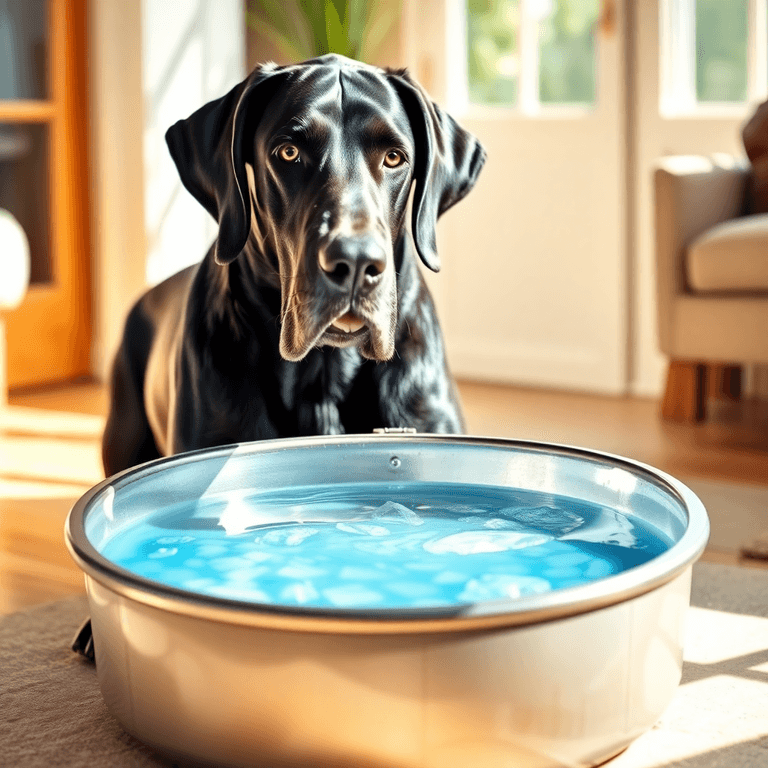
Best Water Bowl for Great Dane
When my humans are picking out the best water bowl for me and my fellow Great Danes, they better make sure it’s heavy and made of stainless steel with at least 64-96 ounces of space. Trust me, we’re four-legged camels who need lots of water, and nobody wants to refill our bowls every five minutes!
Here’s the thing – elevated bowls are amazing because we don’t have to crane our super-long necks down to the floor like we’re doing yoga. It’s much easier on us giants! And please, PLEASE get us wide bowls. My ears are already long enough without getting them soaking wet every time I take a drink. Wet ears are gross, and nobody wants to deal with that mess.
My humans also learned that good materials keep our bowls clean, which means we stay healthy. And when we’re healthy, we can keep being the lovable, clumsy giants that we are! The right bowl makes drinking water so much better for us, big dogs. There are tons of cool features out there that make our drinking experience even more awesome, so let’s check them out together!
Size Requirements for Great Dane Water Bowls
What Size Water Bowl Do I Need? A Great Dane‘s Guide
A tiny bowl just won’t cut it. Picture this: me trying to drink from a Chihuahua’s bowl. My nose barely fits! Plus, I’d knock it over with one enthusiastic tail wag. Been there, done that, got in trouble.
Here’s what works for us giants:
Wide is wonderful. We need bowls that fit our big snouts without bumping our ears. Nothing worse than soggy ear tips while trying to get a drink.
Not too deep, please. Sure, we’re tall, but we don’t want to dive for our water. A medium depth works perfectly – we can drink comfortably without doing a face-plant.
Heavy is helpful. Light bowls go flying when we’re excited. And let’s be honest – we’re always happy about something. A sturdy, heavy bowl stays put during our enthusiastic drinking sessions.
Room to splash. Sometimes we get messy. It happens! A bigger bowl means less water on the floor and fewer dirty looks from our humans.
Additionally, look for bowls that can hold at least 64-96 ounces to reduce the need for frequent refills.
The perfect bowl keeps us happy, hydrated, and out of trouble. Because trust me, a thirsty Great Dane is a Great Dane looking for alternative water sources – like your favorite coffee mug!
Elevated Bowl Recommendations
Hey there, humans! Let me tell you about something that’s a real game-changer for us Great Danes – elevated water bowls!
That’s where elevated bowls come to the rescue! These amazing inventions let me drink water without doing weird yoga poses. No more bending down so far that I feel like I’m touching my toes (if I could reach them). With an elevated bowl, I can just walk up and drink like the dignified dog I am.
The best part? You can get bowls that adjust as we grow. Trust me, we Great Danes do A LOT of growing! One day, I’m a cute puppy, and the next day, I’m accidentally knocking things off your coffee table with my tail. An adjustable bowl grows with me, so you don’t have to keep buying new ones every few months.
Plus, these bowls look pretty fancy! Some of them are so stylish that your human friends might think you upgraded your kitchen just for looks. Little do they know it’s all about keeping your four-legged family member happy and hydrated.
The bonus for you humans? Way less mess! When I don’t have to crane my neck down to floor level, I’m not dripping water all over your nice floors. It’s a win-win situation – I get to drink comfortably, and you get to keep your house from looking like a water park.
And remember, providing the right dietary needs is crucial to keeping us healthy and hydrated!
Material and Durability Considerations
When my humans are picking out a water bowl for me, they had better think about what a dog like me can handle!
Trust me, I’ve destroyed more bowls than I can count (which isn’t very high since I’m a dog, but you get the idea). My humans need to find something super tough because I don’t mean to be rough – I’m just BIG. When I get excited about dinner time or see a squirrel outside, I might accidentally bulldoze right through my water station. Oops!
The bowl also needs to be easy to clean because, let’s be honest, I’m not exactly neat when I drink. I stick my whole giant head in there, and water goes everywhere.
Sometimes I even drop my toys in it or get my drool all mixed in. Gross, I know, but that’s just how us Great Danes roll. Safety is super important, too, because my humans worry about me all the time.
They want to make sure I can’t hurt myself on sharp edges or swallow pieces if something breaks. Innovative thinking, humans! I may be huge, but I still do dumb things sometimes, like trying to eat rocks or chasing my tail until I get dizzy. Additionally, choosing a water bowl made from durable materials can help prevent breakage and ensure it lasts longer against my playful antics.
Best Material Choices
As a Great Dane, let me tell you about picking the perfect water bowl – and trust me, I know a thing or two about drinking! My humans need to choose the right material to keep me happy and healthy.
Stainless steel bowls are pawsome because they’re super tough. I can bump into them with my giant paws, and they won’t break or get rusty. Plus, they’re easy for my humans to clean, which is important since I sometimes drool in my water (oops!).
Ceramic bowls are pretty cool, too. They’re heavy enough that I can’t accidentally push them around the kitchen when I’m getting my drink on. Just make sure my humans check that there’s no lead in them – nobody wants a sick Great Dane!
Now, plastic bowls might look nice and cost less money, but they’re not my favorite. They break easily when a 150-pound dog like me gets excited about water time. Plus, they can get gross and germy, which is definitely not what I want near my snout.
When my humans are shopping for my bowl, they should think about how enthusiastic I get when I’m thirsty. I need something that can handle my size and energy while staying clean and lasting a long time. After all, a happy Great Dane needs lots of fresh water! Additionally, choosing the right bowl material can impact the dog’s health and comfort, ensuring I stay hydrated without any issues.
Durability for Active Dogs
Durability for Active Dogs
Listen up, fellow Great Danes! You know how we love splashing around in our water bowls after a good zoomie session in the backyard. But here’s the thing – our bowls need to be as tough as we are!
I don’t know about you, but I’ve definitely knocked over my fair share of water bowls. Sometimes I get excited and my giant paws just go everywhere! And don’t even get me started on my puppy days when I thought everything was a chew toy. My humans weren’t too happy about that plastic bowl situation.
So what makes a bowl tough enough for us gentle giants? Let me break it down for you:
| Material | Durability | Chew Resistance |
|---|---|---|
| Stainless Steel | High | Excellent |
| Plastic | Moderate | Low |
| Ceramic | High | Moderate |
| Silicone | Moderate | High |
Stainless steel is the superhero of water bowls. It can handle our enthusiasm and won’t get all scratched up when we accidentally kick it across the kitchen floor. Plus, it’s impossible to chew through – trust me, I’ve tried!
Plastic might seem okay, but it’s like tissue paper compared to our powerful jaws. And ceramic? It’s strong, but one good tail wag near the counter and CRASH! You’ll have your humans cleaning up pieces for days.
The bottom line? Pick a bowl that can handle your Great Dane’s energy. Because staying hydrated is serious business, and we need gear that won’t quit on us! Remember, Great Danes are known for their gentle nature, and having a durable bowl will help maintain that calm during meal times.
Hygiene and Safety Tips
Woof! Keeping My Water Bowl Clean and Safe
Here’s what I’ve figured out about the best bowls for us giants:
- Stainless Steel Bowls: These are pawsome! They’re super tough (which is perfect when I accidentally knock mine around), and they don’t let yucky bacteria grow.
- Safe Plastic Bowls: If you go with plastic, make sure it’s the BPA-free kind. I don’t know what BPA is exactly, but my humans say it’s bad for me, and I trust them. They’re the ones with thumbs, after all.
- Heavy Bowls: Get a bowl that’s heavy enough that it won’t go flying when I dive in for a drink. Nobody wants to chase their water bowl across the kitchen floor – been there, done that, got the wet paws to prove it!
- Easy-to-Clean Bowls: Ensure your humans can easily clean your bowl in the dishwasher. They love those machines, and it means my bowl comes out sparkly clean every time. Clean bowl equals happy Great Dane!
Additionally, choosing a bowl made of a heavy-duty material can help ensure it withstands the rough handling typical of larger breeds like us.
Water Intake and Bowl Capacity
You humans think you need a lot of water? Ha! I need about a gallon of water every single day. That’s like four of those big milk jugs you buy at the store. My tongue is a water-slurping machine that never stops working.
Here’s the thing about my water bowl – it needs to be HUGE. I’m talking about a swimming pool (okay, maybe not that big, but close). A tiny little bowl is just insulting to a dog of my magnificent size. When I stick my whole head in there to drink, I don’t want to feel like I’m trying to sip from a teacup.
My bowl should hold at least half a gallon, but honestly, bigger is always better in my book.
And let me warn you – I’m a messy drinker. When I’m done getting my drink on, there’s going to be water everywhere. The floor, the walls, maybe even the ceiling if I shake my head enthusiastically enough.
It’s not my fault, my jowls hold about a cup of water that comes pouring out when I’m done!
You’ll be refilling my bowl at least twice a day, maybe more if it’s hot outside or if I’ve been running around being my awesome self. Keeping me hydrated is essential for my overall health, primarily to support my joint health and prevent any issues like gastric dilatation-volvulus.
Trust me, keeping me hydrated is way easier than dealing with a cranky, thirsty Great Dane!
Daily Water Needs
My Weight = Lots of Water
Here’s the math that even my human can understand: for every pound I weigh, I need about one ounce of water each day. Since I tip the scales at around 150 pounds (don’t judge – it’s mostly height!), that means I need nearly a gallon of water daily. My water bowl isn’t just big for show – it’s practically a swimming pool!
Activity Level Matters
On days when I’m feeling extra playful and decide to sprint around the backyard like the graceful gazelle I think I am, I get even thirstier. Those zoomies really work up an appetite for H2O! My humans have learned to keep extra water handy when we go for long walks, especially since my idea of a “short walk” is probably a marathon for smaller dogs.
Hot Weather = Panting Central
Summer is rough when you’re wearing a permanent fur coat and standing closer to the sun than most dogs. I turn into a panting machine, and let me tell you, all that tongue action makes me incredibly thirsty. My humans always make sure I’ve plenty of cool water available, and sometimes they even add ice cubes – it’s like a fancy spa treatment!
Kibble Makes Me Extra Thirsty
Dry food might be convenient, but it sure makes me hit the water bowl more often. It’s like eating crackers all day – you just need something to wash it down! When I get wet food, I don’t feel quite as parched, but I still make sure to stay hydrated because, well, I’m huge and I need lots of everything.
The bottom line? Keeping me hydrated is serious business, but it’s also pretty simple. Just remember that everything about me is supersized – including my thirst! Also, it’s essential to ensure balanced nutrition in my diet to support overall hydration and health.
Bowl Size Guidelines
Here’s the thing about bowl height – it’s essential! I shouldn’t have to bend down like I’m doing yoga to get a drink. My neck gets sore, and let’s be honest, it’s not very dignified for a dog of my stature. The bowl should be at a comfortable height so I can drink without feeling like I’m doing stretches.
Now, let’s talk about bowl designs because there are some pretty cool options out there. Elevated bowls are fantastic – they’re like having a fancy water fountain just for me! Wide bowls are great too because they prevent me from making a mess. Nobody wants water splashed everywhere, especially my humans who’ve to clean it up.
When I’ve the right-sized bowl, I stay hydrated and happy. That means more energy for important activities like barking at squirrels, taking naps, and convincing my humans to give me extra treats. A good bowl helps me be the best Great Dane I can be!
Refill Frequency Considerations
Since we all know, staying hydrated is super essential for us Great Danes to feel awesome and have tons of energy.
Trust me, when you’re as tall as a small pony like I am, you need A LOT of water! Here are some things us giant pups need to think about when it comes to keeping our water bowls full:
1. Bowl Size: Get a bowl that’s the size of a small pond.
Seriously, those tiny bowls are just insulting to dogs like us. We need something that won’t disappear after three licks!
2. How Much We Drink: Keep track of how much water we gulp down each day.
Spoiler alert: it’s probably more than your little cousin drinks in a week.
3. Hot Weather: When it’s blazing hot outside, we’re going to be panting like we just ran a marathon.
That means our water bowl needs refills more often than a race car needs gas.
4. After Playtime: Once we’re done zooming around the yard or playing fetch, we turn into furry water vacuums.
Make sure there’s plenty of fresh water waiting for us, or we might just stick our whole head in the nearest puddle!
Bowl Shape and Design Features
When my humans pick out a water bowl for me, they should consider the shape and design because it makes a huge difference for a big guy like me!
I need a really wide bowl so I don’t splash water everywhere when I stick my giant head in there. Trust me, nobody wants a Great Dane shake after drinking – it gets messy fast!
Those tall, raised bowls are fantastic because I don’t have to bend my long neck down to the floor like I’m bowing to the water dish. My neck gets tired doing that all day, and it’s not very dignified for a dog of my size.
The bowl also needs a grippy bottom that sticks to the floor. Without it, I end up pushing my bowl around the kitchen like I’m playing hockey.
My humans don’t think it’s as fun as I do, especially when water goes flying under the refrigerator.
Some bowls have these cool edges that stop spills, which is pretty genius if you ask me. My tongue is the size of a small towel, so things can get splashy.
Getting the right bowl makes drinking water way more enjoyable, and trust me, a happy Great Dane means happy humans, too!
Safety and Hygiene Aspects
Safety and Hygiene Stuff (Because Nobody Wants a Sick Giant!)
Here’s what you need to know about picking the right bowl for us gentle giants:
- What It’s Made Of: Please get me a bowl made of stainless steel or ceramic. Those plastic ones might look cute, but they’re like tiny bacteria hotels – gross! Steel and ceramic don’t have little holes where germy stuff can hide.
- Size Matters: I’m huge, remember? Please get me a big bowl so you don’t have to refill it every five minutes. The more you mess with my water, the more chances there are for yucky stuff to get in there.
- No-Tip Design: Find a bowl that won’t flip over when I bump into it with my giant paws. Nobody wants water all over the kitchen floor – especially not me when I get blamed for it!
- Keep It Sparkling: Wash my bowl regularly with pet-safe cleaners. I can smell when it’s dirty way before you can, and trust me, stinky water isn’t refreshing.
Follow these rules, and we’ll both be happy campers!
Final Thoughts
When I’m thirsty after a good zoomie session around the yard, I need SERIOUS hydration. Those tiny bowls meant for chihuahuas? Please! I could empty one of those with just two licks.
First things first – size matters! My water bowl needs to hold enough water for a small swimming pool. Okay, maybe not that big, but you get the idea. I’m a growing boy (even at 150 pounds), and I drink like I just crossed the desert.
Height is super important, too. Do you know how awkward it is to bend this long neck down to floor level? It’s like doing yoga every time I want a drink! Elevated bowls are my best friend. They save my neck and my dignity.
Materials? Well, I’m not picky, but stainless steel is pretty awesome. It doesn’t break when I accidentally knock it over with my enthusiastic tail wagging. Plus, it stays clean, which makes my humans happy. Happy humans mean more treats for me!
Here’s the thing about us Great Danes – we’re gentle giants with big hearts and even bigger thirsts. We need bowls that can accommodate our size while also making drinking comfortable.
So there you have it, straight from the horse’s mouth – or should I say, the Great Dane’s mouth! Get us a big, tall, sturdy bowl, and we’ll be your best friends forever. Well, we already are, but you know what I mean!
References
- https://4inbandana.com/blog/what-size-dog-bowl-do-i-need/
- https://bearwoodessentials.com/pages/dog-bowl-size-chart
- https://greatdanecare.com/how-much-water/
- https://shophiddin.com/blogs/news/how-to-choose-the-best-bowl-size-for-your-dog
- https://www.akc.org/expert-advice/nutrition/choosing-right-dog-bowl/
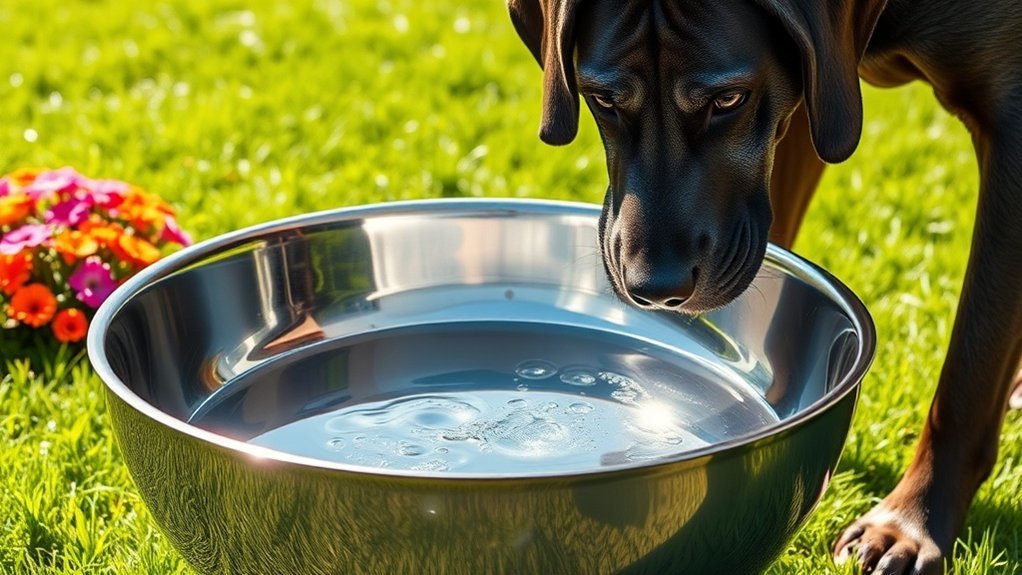
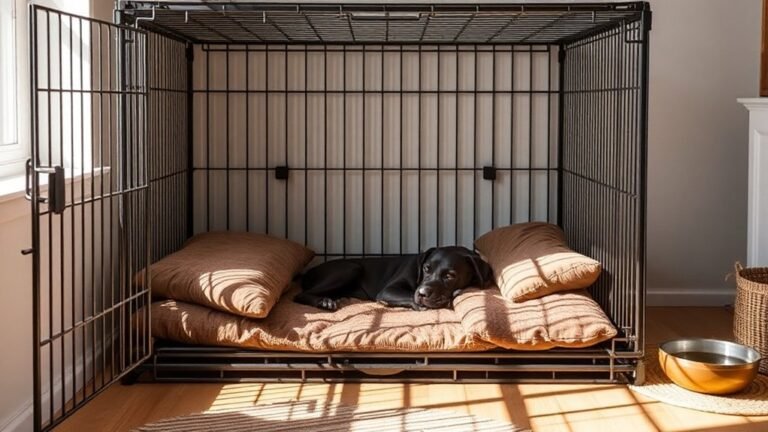
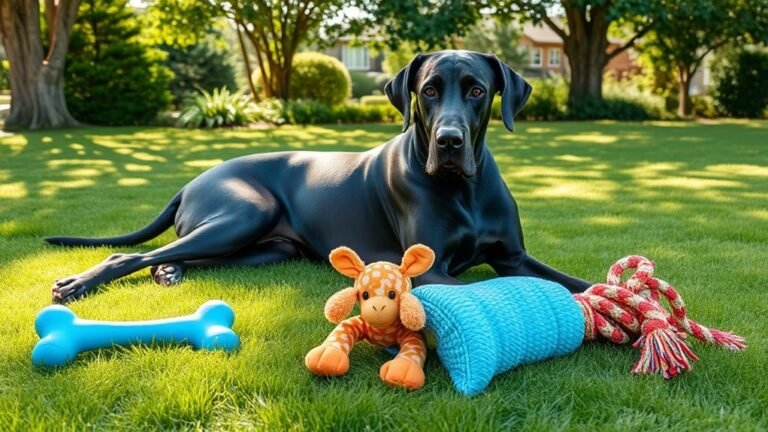
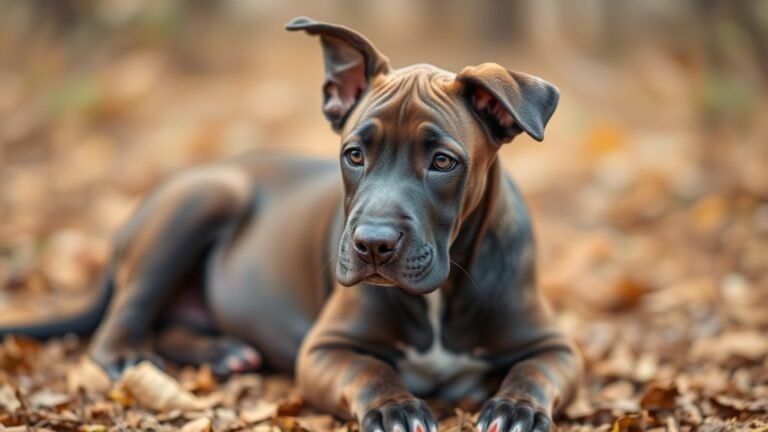
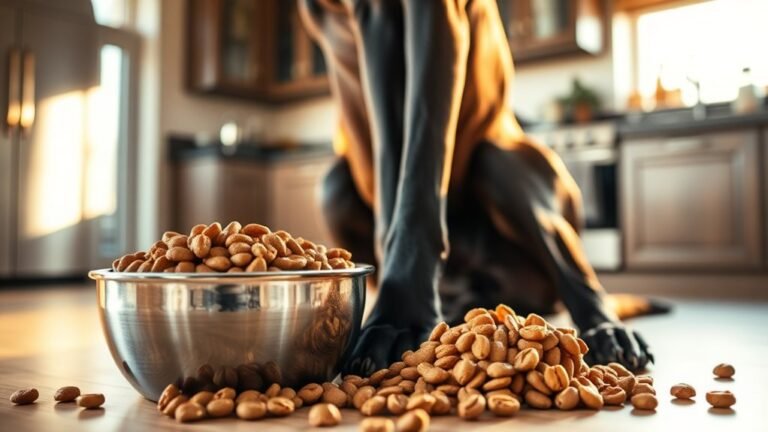
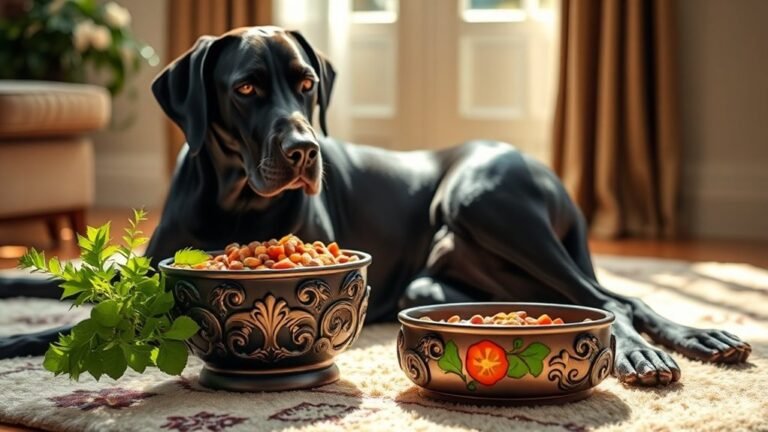
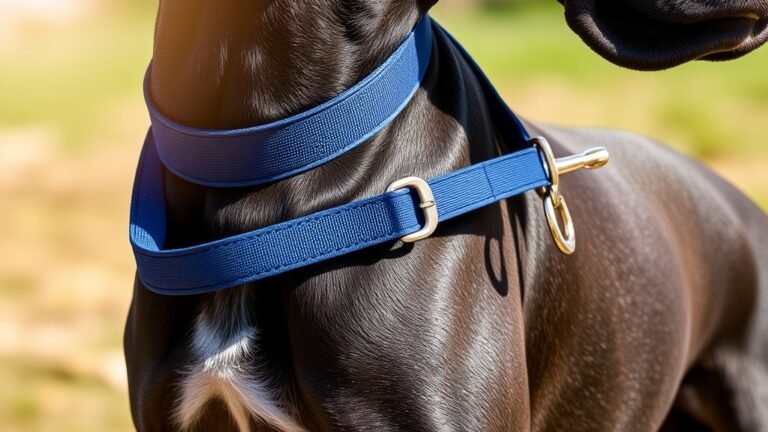
2 Comments